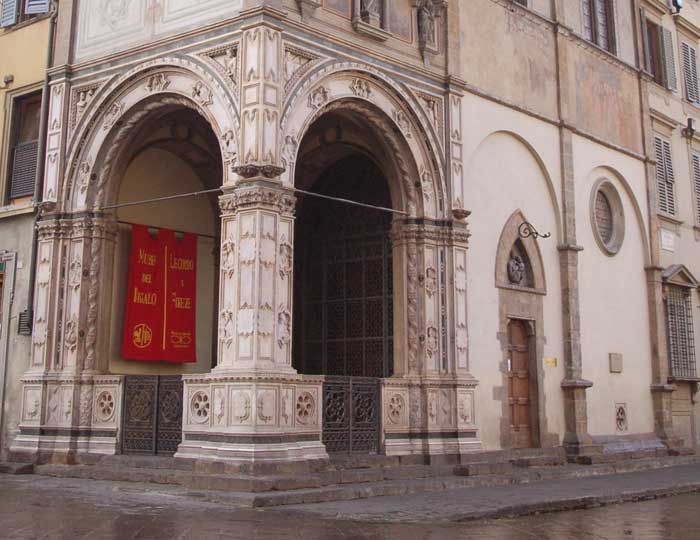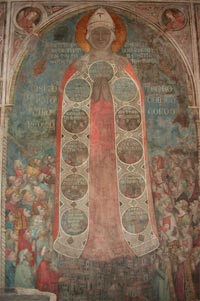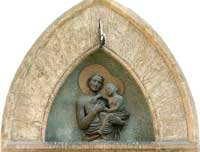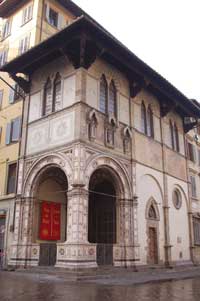| |
|
| |
|
|
|
|
|
|
| |
 |
 |
|
 |
 |
The Loggia del Bigallo, on the corner of the piazza of the Duomo and via Calzaioli, Florence
|
|
 |
 |
| |
|
|
|
| |
|
Tuscany Travel Guide | Art in Florence | Loggia del Bigallo (Museo del Bigallo)
|
|
|
|
| |
|
The Loggia del Bigallo is a late Gothic structure in Florence. It is one of a dozen public loggias in the city, in this case part of a construction that housed the Compagnia della Misericordia, who commissioned the structure, probably from the architect-sculptor Alberto Arnoldi [1]. The Loggia del Bigallo was built in 1352–58. The open loggia served to shelter lost children and unwanted infants who were abandoned to the care of the brotherhood, the Company of Mercy. In 1425 the Compagnia di Santa Maria del Bigallo, founded in 1244 by Saint Peter Martyr and formerly housed near Orsanmichele, transferred here as well. The Compagnia del Bigallo cared for pilgrims and travellers at their Ospedale di Santa Maria "del Bigallo" at Fonteviva.
The museum is situated in the Loggia, the oratory and some of the ground and first floor rooms of the palace that stands on the corner between Via Calzaiuoli and Piazza San Giovanni. It contains a series of devotional works that form a homogenous collection and illustrate the life of the Confraternity over the centuries. Some of the more important works include a painted Crucifx by the Maestro del Bigallo (mid 13th century), a portable triptych by Bernardo Daddi dated 1333 (Madonna and Child with 14 Saints), a Madonna and Child by Alberto Arnoldi (1361), the coat of arms of the Altoviti family carved by Desiderio da Settignano (1450 circa), a Madonna by Jacopo del Sellaio (1480 circa) and paintings by Ridolfo del Ghirlandaio (1515).
The oratory contains the remains of sinopites and frescoes, carried out in 1363-64 by Nardo di Cione and his workshop, which were found behind the carved altar (the work of Noferi d'Antonio) that in 1515 covered most of the wall. However the most famous work in the museum is a fresco of 1342 dedicated to the Madonna of the Misericordia, carried out by the workshop of Bernardo Daddi, pupil of Giotto.
|
|
|
|
| |
|
Situated on the corner of the piazza of the Duomo and via Calzaioli, the mid-14th century Loggia del Bigallo has been a small museum since 1904. Even from outside, you can admire the frescoed building, but heading inside will give you a chance to see the much deteriorated but famous fresco of the Madonna della Misericordia, an image of the Virgin Mary with her cape encompassing her devotees (in this case the entire city) who are surrounded underneath and around her. The Bigallo Madonna is depicted with the oldest known view of Florence, from 1352.
Its two arched bays are richly applied with bas-reliefs of prophets, angels, the Virtues, a Christ giving the benediction and an Ecce Homo. In 1697, the arches were immured in order to provide more space for the oratory that is attached to the loggia; the masonry was removed in 1889, revealing the long-hidden decoration. Bifore windows pierce the walls of the floor above, which was originally richly frescoed, and three tabernacles, the work of Filippo di Cristofano, 1412, enframe the Madonna and Child, Saint Lucy and Saint Peter Martyr, patron of the brotherhood. The mid-14th century statues were installed here when the two confraternities joined in 1425.
Since 1998 the Loggia del Bigallo has been run by the Museo of the Opera del Duomo. Its beginnings, however, were as the main seat of the Misericordia, a catholic confraternity founded in Florence in the 13th century to help those in need, which at the time consisted of mostly people affected by the Plague.
|
|
|
|
 |
The Bigallo Madonna della Misericordia is depicted with the oldest known view of Florence, from 1352, including the Baptistery and an interesting view of the Cathedral during the construction of Santa Maria del Fiore. The old cathedral of Santa Reparata was still standing so that here we can pick out its saddle roof, two belltowers and lateral single light windows. Parts of Giotto's Belltower and the facade of Santa Maria del Fiore, as it had been conceived and left by Arnolfo at the time of his death in 1302, can also be seen.
|
The Madonna of Mercy, painted by the Bernardo Daddi school in 1342, is one of the most important keys for unlocking the vocation and for deepening the meaning of Florence. [2] The Madonna wears a crown like that of the Empress Matilda, with the saving Tau in blood, and it is she who protects the city with the weapons of the acts of mercy as Jesus had listed them in the Gospel, these acts being given in the medallions of her mantle that contain these words.
The fresco, painted on a wall of the Room of the Captains, is the oldest known representation of Florence, showing its mediaeval towers and monuments, including the Baptistery and an interesting view of the Cathedral during the construction of Santa Maria del Fiore. The old cathedral of Santa Reparata was still standing so that here we can pick out its saddle roof, two belltowers and lateral single light windows. Parts of Giotto's Belltower and the facade of Santa Maria del Fiore, as it had been conceived and left by Arnolfo at the time of his death in 1302, can also be seen.
'Two recently published documents have revealed the former presence of an important fourteenth-century fresco cycle that included ten scenes of the Virgin Mary. They covered portions of the currently whitewashed walls on the ground-floor level, against which the museum's collection is now displayed. Their loss is unfortunate for a number of reasons, not least because these paintings probably demonstrated the inventive powers of their creator, Jacopo di Cione -- a major figure in Florentine late-Trecento art -- at the moment he emerged as an independent master and before his ingenuity began to flag. More than that, however, they point to the curious fact that, to date, there has been no attempt to understand -- as far as one can -- what would seem to be the underlying assumption tying together a large percentage of the collection.' [3]
Art in Tuscany | Madonna della Misericordia | Madonna of Mercy
|
|

The Madonna della Misericordia, an anonymous 14th century fresco in the Bigallo, Florence. |
|
|
| |
|
|
[1] Alberto Arnoldi (or di Arnoldo) was a 14th century Italian sculptor and architect, and one of the most important sculptors in Florence of his day. In 1364, he made the colossal group of the Madonna and Child with two angels (originally attributed by an error of Vasari to Andrea Pisano) for the Loggia del Bigallo in Florence. Arnoldi worked at this group from 1359 to 1364.
As architect, he directed the works of Florence Cathedral about 1358.
He was According to the contemporary poet Sacchetti, Arnoldi was in Milan for a long period, but there is no other evidence for this. He is first mentioned in 1351 in the cathedral works in Florence, where he was working as a mason on marble inlay for the campanile. In 1355 and 1358 he was listed as one of the advisers for the construction of the cathedral.
For the architectural history of the Loggia del Bigallo, see Howard Saalman, The Bigallo: The Oratory and Residence of the Compagnia del Bigallo e della Misericordia in Florence (New York: New York University Press for the College Art Association of America, 1969); and the review of this book by Marvin Trachtenberg published in Art Bulletin 53 (1971): 521-23.
|
|

Alberto Arnoldi, Madonna del Bigallo
|
[2]
Bernardo Daddi
was the outstanding painter in Florence in the period after the death of Giotto (who was possibly his teacher). Daddi ran a busy workshop specializing in small devotional panels and portable altarpieces. His signed and dated works include a polyptych of The Crucifixion with Eight Saints (Courtauld Institute, London, 1348) and the works attributed to him include frescos of the Martyrdoms of SS. Lawrence and Stephen in Santa Croce. His style is a sweetened version of Giotto's, tempering the latter's gravity with Sienese grace and lightness. He favoured smiling Madonnas, teasing children, and an abundance of flowers and trailing draperies. His lyrical manner was extremely popular and his influence endured into the second half of the century.
[3] William R. Levin, A Lost Fresco Cycle by Nardo and Jacopo di Cione at the Misericordia in Florence, Burlington Magazine 141, no. 1151 (February 1999): 75-80. See also jps.library.utoronto.ca
|

The hidden secrets of southern Tuscany | Podere Santa Pia
|
 |
Overlooking the vineyards and beautiful hills of the Maremma,Podere Santa Pia is an excellent base for making excursions
|
| |
|
|
|
|
|
| |
|
|
|
|
| Wikimedia Commons has media related to Museo del Bigallo (Florence) |
|
|
| |
|
|
|
| |
|
|
|
| |
|
|
|
| |
|
|
|
| |
|
|
|
| |
|
|
|
![]()
![]()
![]()
![]()
![]()






